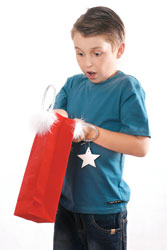 “How was the birthday party?” a Seattle mom asks her 6-year-old as he climbs into the back seat of the family car, goody bag in hand. After a pause, the boy replies, “Well, when Josh opened my present, he said he didn’t really like Thomas trains. And Alex cried because he didn’t get to sit by Josh.”
“How was the birthday party?” a Seattle mom asks her 6-year-old as he climbs into the back seat of the family car, goody bag in hand. After a pause, the boy replies, “Well, when Josh opened my present, he said he didn’t really like Thomas trains. And Alex cried because he didn’t get to sit by Josh.”
Sound familiar? While starchy party dresses and little bow ties have been replaced by hoodies and cargo pants, good old-fashioned party manners are still very much in vogue — and matter as much today as ever. There are basic party rules and rituals designed to help both guests and hosts feel appreciated and at ease.
Birthday parties are one of most kids’ first public social situations, according to Corinne Gregory, founder of the Bellevue-based manners school The PoliteChild (see “Teaching tots to share”). “Party manners are really just an extension of what we do every day,” Gregory says.
Encouraging good manners means “equipping children with motivators — not just telling them, ‘Here’s how to act,’ but ‘Here’s why we act this way,’” Gregory says. “The Golden Rule [do unto others as you would have others do unto you] will take kids through 90 percent of party etiquette.”
Gregory’s message to young birthday boys and girls? “Even though it is your party, you’re responsible for your guests’ good time.” A fundamental goal at The PoliteChild is to teach children “outside thinking” — thinking outside themselves to consider how others might feel.
Planning a party?
Gregory suggests the following:
- Help guests know what to expect by removing ambiguity from the invitation. Specify any clothing suggestions and an end time for the party.
- Let kids know that, unless the party requires mess-friendly clothes, it is OK to dress up a bit more for the party. This honors the occasion.
- Parents of young hosts and young guests should be specific with their children about expectations. “Don’t say, ‘Be on your best behavior,’” Gregory says. “Say, ‘I expect you to greet your guests at the door and thank them for coming.’” Role-play various possible situations with them.
- Don’t invite more children than you can manage. This will help you retain the grace and stamina to encourage continued good party manners throughout the event. Does your child’s school have an “invite everyone” policy? “That is ridiculous!” Gregory says. “It is prohibitively expensive, RSVPs will not work with such a large guest list, and finding a large-enough location becomes very difficult.” The rational to include everyone is to avoid hurt feelings, something Gregory calls unrealistic. “Life isn’t always fair, and children know this.”
- If gifts are given, they should be opened at the party — no whisking them away for later, Gregory says. “Part of the joy we have in giving gifts is seeing the look of joy on the recipient’s face. The person giving the gift is trying to please you.” Don’t want to deal with gifts at the party? Just specify “no gifts!”
- Help kids practice receiving gifts graciously. Remind them to focus on the giver’s motivation. Practice handling situations, such as what they should say if they open a duplicate gift.
- Kids of all ages should write thank-you notes, not just for the gifts, but to thank the guests for being part of the occasion. “The biggest present,” Gregory says, “is the presence of each other.”
Paula Becker is a Seattle freelance writer and has three children.
Resources
The PoliteChild offers classes for schools, scout troops and other groups, as well as a guide — Party Manners Worth Celebrating — downloadable for $4.95
Books
Emily Post’s The Guide to Good Manners for Kids by Peggy Post and Cindy Post Senning, Ed.D.
Miss Manners’ Guide to Rearing Perfect Children by Judith Martin (older but widely available used or from libraries)









